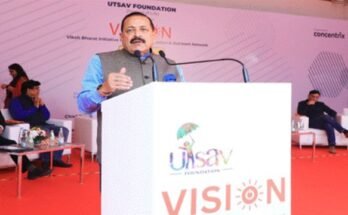At the age of 17, Soni was married off, and thereafter, not allowed to work or study further. It took her almost seven years to convince her family to hand over her school certificates so that she could enrol for training to start work.
She now receives training in cosmetology in Ghitorni, New Delhi, and dreams of a brighter future for her children. She is happy to be contributing to the running of the household.
“We have multiple stories of such women who have found employment with a little support,” says Clement Chauvet, Chief, Skill and Development, United Nations Development Programme (UNDP) India.
In a conversation with HerStory, he speaks about skill development, how it has impacted the lives of women across India, and the target of reaching one million women that UNDP’s Project Disha has undertaken.
Why women, and why skilling?
According to Clement, data from the International Monetary Fund shows that the participation of women in the workforce in India is very low, and that the GDP will increase by 27 percent if the participation of men and women becomes equal.
While we are seeing more and more women enrol in secondary and higher education, it is not translating to them participating in the workforce.
“They are actually working and, most of the time, working harder than the men, but most work they do is confined to household activities like caring for the kids, cooking, and cleaning,” Clement notes.
He adds that it is important that this changes. “At the community level, we believe that when women start earning money and become economically empowered, they start bringing money in at the household level, and therefore, become part of the decision-making process. Women take better decisions, especially when it pertains to household expenditures. They are going to invest in the future of the family, and will ensure the kids can go to school, get proper food and nutrition, and access to good sanitation. This will create a virtual cycle of prosperity that would benefit not only the family but the community and the society,” Clement says.
He notes that by 2030, India will have the largest youth population in the world, while Europe, Japan, and America will have an ageing one. “This means that these countries will have a deficit in terms of skilled workforce, while India has a huge potential to cover that deficit. But young people in India are not skilled enough to make sure that India becomes the skill capital,” he adds.
And UNDP’s Project Disha was started to address this gap, by focussing on skills and employment for women.
Making women employable
Project Disha is a partnership between UNDP, India, IKEA Foundation, and India Development Fund. The project helps women acquire marketable skills and become employable. The aim is to improve the lives of one million underprivileged women in India through the project.
Clement adds: “Disha supports women to become economically self-sufficient so that they and their families can have better and equitable opportunities in life.” Other than this, the project also works towards developing “innovative and scalable public-private partnership models” and “establishing a continuum that connects education to skills, jobs, and growth.”
The project started in late 2015 and, in the last three years, has rolled out 70 pilots, and benefited over seven lakh underprivileged women across five states. It is based on four models.
Clement explains, “After working on skill development and on looking at innovative solutions for creating employment opportunities, I realised that there is huge gap between the employers, the job-seekers, and the market. I also noticed that this gap exists between the farmers and the private sector companies as well, thus impacting their livelihoods. So we created four different models, and enabled women to break stereotypes in their roles – by helping them become entrepreneurs, do the jobs of a sourcing manager in the agriculture sector, to become counsellors in the employment marketplace, etc. And my biggest learning has been this: we need to first reduce the gaps in information and connect dots between the private sector, beneficiaries, government and the job-seekers.”
The first model revolves around career guidance and counselling in government schools and colleges. It enables girls from underprivileged sections to be aware and make informed career choices.
The second model is that of a marketplace which, through collaborative platforms, connects aspirations of young women with the requirements of potential employers. A case in point is Chandini, a 17-year-old student who attended computer classes at one of the centres. She wants to become a teacher, and will pay for her teaching course by learning stitching.
The third model is one of micro-entrepreneurship, which focuses on building a network of mentors who provide business and psycho-social support to help women start small businesses. The fourth is the value chain. “The value chain aims at maximising the value for the women producer situated at the lower end of the value chain by promoting women collectives and linking them with the organised market in areas such as agri-produce, handlooms and garments, and artisanal products,” Clement says.
These models come together in the three pilots IKEA Retail supports. It is promoting organic farming among women farmers, and uses their produce in its in-house cafe in Hyderabad. Apart from this, it provides training and placement in jobs, and promotes capacity building of women in modular furniture assembly, for which IKEA works with UrbanClap. Clement says that under the pilot, 30 unskilled women aspirants were skilled in modular furniture assembly. “On successful completion of training and certification, the women assemblers will be linked to UrbanClap. The National Academy of Construction (NAC), Government of Telangana has been selected as the training agency for this pilot,” he adds.
Replicating a successful and sustainable model
At the end of 2018, Project Disha had reached 7.7 lakh girls in the country. “Some will choose a better career armed with more information about future opportunities available to them, while others may start their own businesses,” he says. He is confident that Project Disha will reach one million women by the end of 2019.
“For us, the million is just a number but our main aim is to really to create a replicable and scalable sustainable solution,” he adds.
But more than the numbers, individual stories warm the heart and highlight the kind of work being done. Take, for example, 21-year-old Shireen Begum who, after a 45-day retail training programme with IKEA, found employment in the IKEA Food Function department. Her sister, Samreen, too, joined the restaurant after training. But the dream to go big continues. “I see myself working in a managerial position in the future,” Shireen quips.
With more and more women receiving skills, training, and career guidance under UNDP, or through other organisations, the message is clear: women have the potential and the aspiration, and backed by skills, more and more women like Shireen can work towards their dreams.



